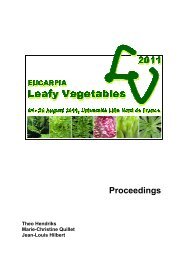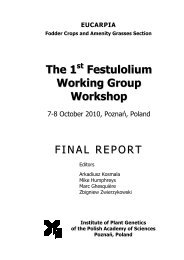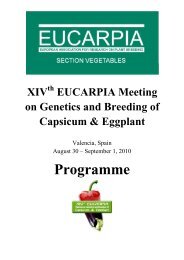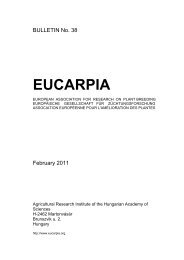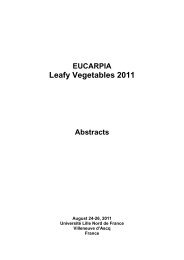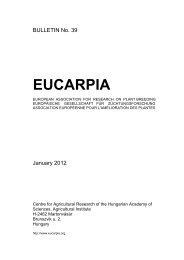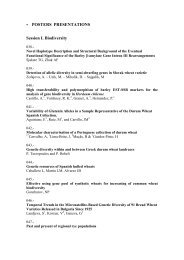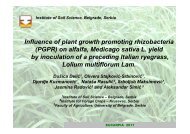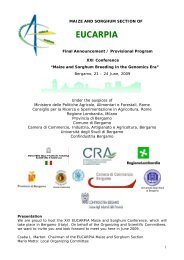Plant breeding for organic and sustainable, low-input agriculture
Plant breeding for organic and sustainable, low-input agriculture
Plant breeding for organic and sustainable, low-input agriculture
Create successful ePaper yourself
Turn your PDF publications into a flip-book with our unique Google optimized e-Paper software.
Genotypic variation of attack degree (AD%) with downy mildew<br />
(Plasmopara viticola Berk & Curt) in six grape varieties, under chemical <strong>and</strong> <strong>organic</strong><br />
control treatments<br />
Claudiu Bunea, Marin Ardelean,<br />
University of Agricultural Sciences <strong>and</strong> Veterinary Medicine, Cluj-Napoca, Romania<br />
Six grape varieties (three domestic <strong>and</strong> three <strong>for</strong>eign) destined <strong>for</strong> wine production (Aromat de<br />
Iaşi, Pink Traminer, Italian Riesling, Fetească Regală, Muscat Ottonel, Blasius) were tested in<br />
2006, in Gherla, Cluj county, Romania, concerning their level of attack degree (AD%) with<br />
downy mildew (Plasmopara viticola Berk & Curt) under two types of control treatments:<br />
chemical <strong>and</strong> <strong>organic</strong>. Two treatments were applied both in the chemical <strong>and</strong> <strong>organic</strong> variants of<br />
control. The chemical treatments consisted in SHAVIT 72 WP, 0.2%, be<strong>for</strong>e f<strong>low</strong>ering stage,<br />
<strong>and</strong> Curzate Manox 0.25% between f<strong>low</strong>ering <strong>and</strong> green grape berry stages while the <strong>organic</strong><br />
treatments consisted in Bordeaux mixture 0.5% + purine of greater nettle 1/20 dilution, be<strong>for</strong>e<br />
f<strong>low</strong>ering <strong>and</strong> Bordeaux mixture 0.75% + soluble sulfur 0,4% between f<strong>low</strong>ering <strong>and</strong> green<br />
grape berry stages. There resulted a trifactorial experiment (types of treatments, genotype <strong>and</strong><br />
number of treatment) with a total number of 24 variants.<br />
Both variety, type of treatment, number of treatments <strong>and</strong> two simple interactions (type of<br />
treatment × variety <strong>and</strong> type of treatment × number of treatments) showed significant effects on<br />
AD% level while the triple interaction (type of treatment × variety × number of treatments)<br />
proved nonsignificant. The <strong>low</strong>est AD% level was registered in Aromat de Iaşi <strong>and</strong> Pink<br />
Traminer varieties (AD% = 1.08) while the highest AD% was found in Italian Riesling (3.07%),<br />
the intervarietal coefficient of variability <strong>for</strong> this character being rather high (32.6). These results<br />
are in total agreement with previous data published by other authors (Husfeld, 1962; Zăvoi,<br />
1979; Deacon & Berry, 1993; Cheregi, 2003) who found an impressing intervarietal variability<br />
of AD% level among different grape varieties, both under natural or/<strong>and</strong> artificial inoculation<br />
with downy mildew. The general effects of chemical treatments were slightly better than those<br />
of the <strong>organic</strong> ones as far as the AD% was concerned (1.47% vs. 2.11%), but it must be<br />
emphasized the fact that in the least sensitive varieties (Aromat de Iaşi <strong>and</strong> Pink Traminer) the<br />
AD% level was, practically, identical both under chemical <strong>and</strong> <strong>organic</strong> treatments. These results<br />
are of great interest since such varieties seem to be better adapted to <strong>organic</strong> control practices of<br />
downy mildew <strong>and</strong>, conseqeuently, are recommended <strong>for</strong> <strong>organic</strong> grapeyards <strong>and</strong>, on the other<br />
h<strong>and</strong>, they could prove as valuable genitors in creating new grape varieties adapted to <strong>organic</strong><br />
control of downy mildew.<br />
30




